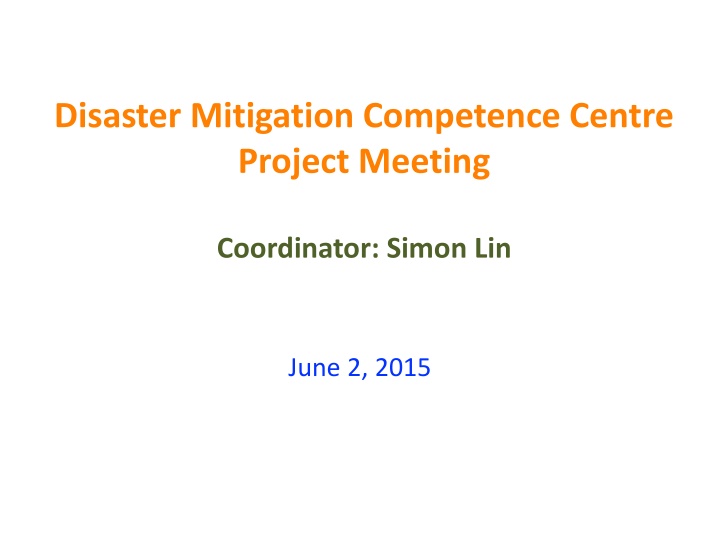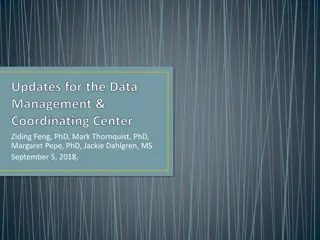
Disaster Mitigation Competence Centre Project Meeting Summary
Join the Disaster Mitigation Competence Centre Project meeting coordinated by Simon Lin on June 2, 2015, for progress reports, partner status updates, and discussions on future events. Explore proposed case studies and collaboration details, aiming to shape a sustainable society through open collaborations and capacity building. Learn about competence centers in EGI, their role in developing community-specific ICT platforms, and promoting scientific applications. Stay informed about current VRCs and UCB representatives involved in the project.
Download Presentation

Please find below an Image/Link to download the presentation.
The content on the website is provided AS IS for your information and personal use only. It may not be sold, licensed, or shared on other websites without obtaining consent from the author. If you encounter any issues during the download, it is possible that the publisher has removed the file from their server.
You are allowed to download the files provided on this website for personal or commercial use, subject to the condition that they are used lawfully. All files are the property of their respective owners.
The content on the website is provided AS IS for your information and personal use only. It may not be sold, licensed, or shared on other websites without obtaining consent from the author.
E N D
Presentation Transcript
Disaster Mitigation Competence Centre Project Meeting Coordinator: Simon Lin June 2, 2015
Agenda Introduction (Simon Lin) From Previous Meeting on May 18, 2015 (Eric Yen) Progress Report (Eric Yen) Partner Status Report Discussion Future Events AOB
Minute of DMCC Project Meeting on May 18 1700-1830, May 18, 2015 at EGI Conference, Lisbon, Portugal Participants: Simon Lin and Eric Yen (TW), Rahim (MY), Cerlane (DE), and Gergely (EGI) Progress Report Partner contributions are summarized as the next slide Proposed case studies: Flood 2011 (TH), Flood 2014 (MY), Tsunami (PH) EGI Collaboration: CCs will meet the EGI-AAI team on May 22 for AAI requirements and services Discussion Detailed steps, schedule and roles of partners for the designed case studies have to be well planned as soon as possible. Scenario design: Partner needs to identify what we have and what are missing, the target of the disaster analysis from the next meeting. Cerlane explained the Advanced visualization facility and working model with scientific group. Next Meeting: June 2, 2015 3
Excellence Strategy Capacity Building and Shaping the Sustainable Society Open Collaborations to All APGI Partners and Beyond Long Distance Dust Transportation Earthquake & Tsunami Extreme Weather Urban Heat Island Impact Web Portal TW TW TW TW MY, PH, TH, TW Case Study ID, PH, TW ID, TW TW Resource Center EGI compatible regional e-Infrastructure (TW and all Asian partners) Visualization DE Service & Support MY, PH, TH, TW ID, PH, TW TW TW Other EGI: infrastructure, AAI, application technology etc. Domain experts/project in Europe, etc. Collaborations 4
Current VRCs and UCB representatives 4/4/2025 6
Competence Centres in EGI Experiment, develop and deploy community-specific ICT platforms using EGI solutions Evolve the EGI technical services with community requirements co-development with NGIs Promote community services within scientific groups EGI-enabled scientific applications Joint training programme Technical user support Promote reuse of solutions of common interest across research communities Initial model in EGI-InSPIRE, new model in EGI-Engage EGI-InSPIRE NGI/Community/Technology; Flat list EGI-Engage Projects within the project ; Focus, timeline 4/4/2025 7
Competence Centre model in EGI-Engage wiki.egi.eu/wiki/EGI-Engage:WP6_(SA2)_Knowledge_Commons Implementation in WP6 (Knowledge Commons) 7 Comp. Centres for 7 RIs from the ESFRI roadmap BBMRI, DARIAH, EISCAT_3D, ELIXIR, EPOS, INSTRUCT, LifeWatch 1 Asian Competence Centre for Disaster mitigation Goals Experiment, develop and deploy community-specific ICT platforms Sustainable adoption of e-infrastructure services Dissemination, training, exploitation within the RIs Implementation CC=group of Sci. institutes + Software providers + Resource centres 5-7 core partners + Unfunded contributors from any NGI Focused workplan with tasks, effort, owners, deliverables, deadlines 4/4/2025 8
Outcomes Training resources Community clouds Data products Active Repositories GPU federations Science gateways Scalable applications User support Advanced AAI Open Science Environme nt (disaster mitigation) MoBRAIN / INSTRUCT EISCAT- 3D EPOS ELIXIR DARIAH LifeWatch BBMRI EGI community High Data Security, access control Gateway systems Federated Cloud Throughtput Computing management and federation 4/4/2025 9
4/4/2025 10
Conference programme overview Key sessions for VRCs and CCs Technology topics IaaS, PaaS and Operations, Open data, AAI Service operations Tools and services Outreach and engagement with new communities E-learning needs, tools, plans Business - Industry engagement, Procurement, Marketplace Comm. Spec. topics Licences, Citizen involvement, GPGPU Training courses FitSM, Security, CernVM-FS Notes, Q&A - Links in the agenda (e.g. go.egi.eu/iaas) For session conveners: workshop reports! (see my email) 4/4/2025 11
AAI Requirements of DMCC Earthquake & Tsunami Extreme Weather Long-Dist Dust Transportation Urban Heat Island Impact Input (Multiple Sources/cou ntries) Time varing meteo fields; Terrain, Landuse, soil; Aerosol source; Time varing meteo fields; Terrain, Landuse, soil; Rupture Profile; Precomputed DB; Bathymetry; Obs; Land Use; Terrain; dynamic meteo. Data; Time-series Seismograms/Tsuna mi wave @site; hazard map; animation; Pub. Time-series gridded data (NetCDF); animation; Pub. Time-series gridded data (NetCDF); animation; Pub. Time-series gridded data (NetCDF); animation; Pub. Output (Scientific Results) AP Platform Model, Program, Platform, Web Portal, and Services (with version control) Access to Web Portal & EGI compatible regional/global e-Infrastructure; Management of Scientific Results (various stages; organized/DB) Scientist Other Users Access to open contents: Pub., Animation, Report, Case Study Service & Support Roles: Data Source; Scientist; Tech Supporter; Resource Providers; General Public System AAI (Simplest workflow to get services; SSO; required data and access protection); Certified system images and app platform; Access Control; 4/4/2025 Requirement 12
Summary Based on the use cases and requirements from user communities, and the DCI federated environment Based on certificates of IGTF, the APGridPMA network VO, Science Gateway will be implemented Role-based access control AAI is not just for access control, but also for supporting the service provenance, level of assurance, and trust (between user and service provider; between service providers; between application platform and infrastructure). Required Services Integration with user s existing data/storage/service Federated ID Credential translation, group/attribute management Endorse personal data attributes Certification of services, resources, etc. Interoperability with the raw data sources: distribution center model Common Policy for DCI: Compliance to standards, agreed policy and practices 4/4/2025 13
EGI Training Development Steps Who do you want to train? What is their existing knowledge / skills that are relevant? What extra knowledge, skills or behaviour do they want to acquire? How many are there (e.g. demand/year)? What resources can they contribute? What is the syllabus? New material (skills, methods, knowledge, judgement, behaviour) you plan to deliver. This needs to be reviewed with the stakeholders identified in 1 to see if it is what they want. But the stake holders are also their (future) employers, etc. How will the content of the syllabus be developed and delivered so that people absorb the required increments to their knowledge and skills? How can this be resourced from the point of view of developing the material and delivering the material? How can the identified students (people engaging to learn) find (a) the prerequisites if they don't have them, (b) the time & engagement to learn, and (c) coping with the pace and duration? i.e. should there be identified stages? How will the learners be supported, e.g. tele- tutoring and group discussions? How will it be made concrete so progress is appreciated?, e.g. What practical exercises are there? How are the preparation staff resourced to deliver? How are the delivery staff resourced to support each replay of the course? How are the technical support arrangements made, e.g. we need to book time on EGI machines to teach forward wave propagation modelling, about 20 nodes / student. How do the courses deal with student feedback? Solicit it? Discussions during the course and a suitable time later? Review of their progress by their organisations Integration and distillation of the analysis Identification of the areas needing action. Revision of any of the previous stages. This is key particularly the first rendition of the course must be considered a trial run, before it is considered prepared! 14
Action Items Plan for the DMCC Face-to-Face Meeting in APAN 40 (Aug. 10-14 in Kuala Lumpur) (ALL) Objectives: Review the preliminary results, services and workflow by Interacting with Users on target case studies Review the requirements, collaboration model, system architecture and the outcomes Arrangement: Half day or Full day Agenda Support WRF analysis first before the new gWRF portal is available (ASGC) Review the status of proposed cases (ALL) Invite APGI and other regional user communities to work together (ASGC) Engage or make use of EGI, VRC and other CCs (ALL) Environmental Computing Workshop, ISGC 2016 (ALL) 15
Next Meeting & Future Events June 16, Progress Checking June 30, Progress Checking Aug. 10-14, APAN40, Kuala Lumpur, MY DMCC face-to-face meeting Environmental Computing Workshop, ISGC 2016

